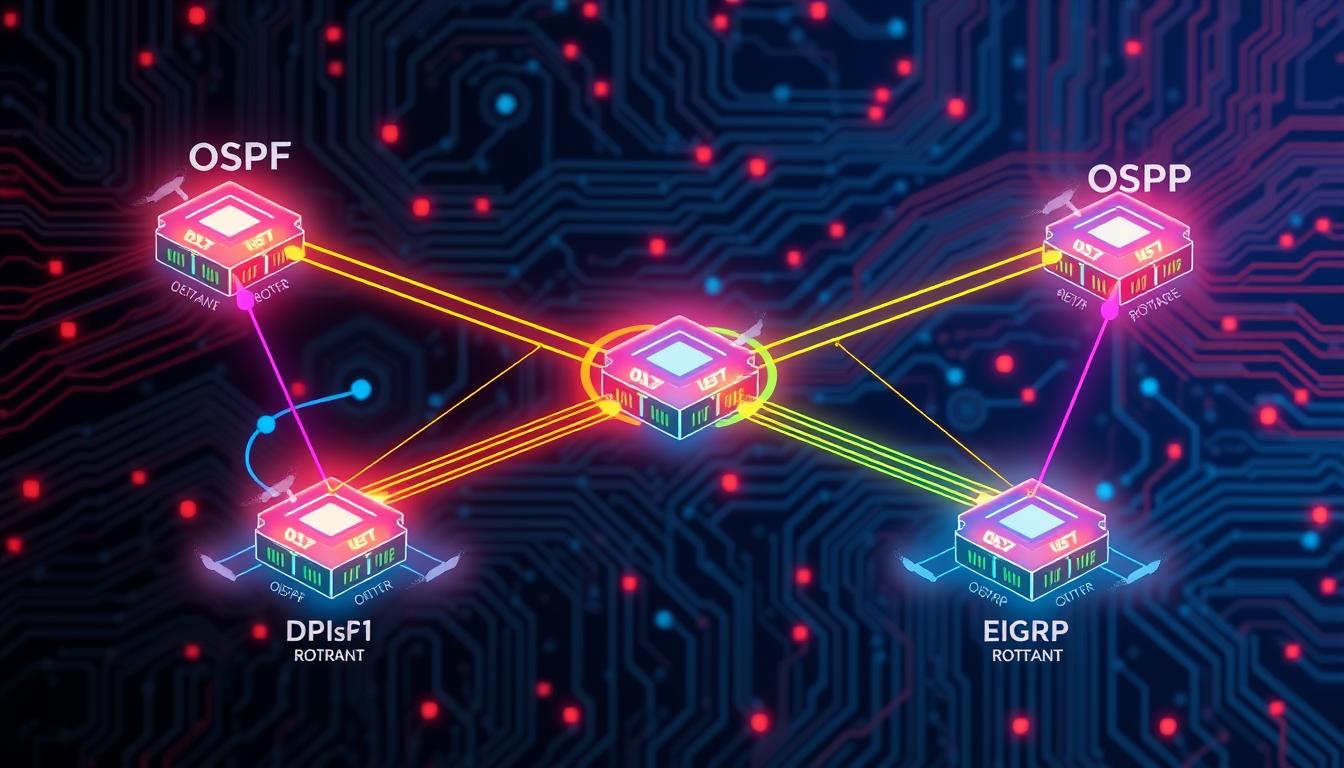Did you know that OSPF and EIGRP make up over 75% of routing decisions in today’s networks? These dynamic routing protocols are key in modern Routing and Switching. This guide focuses on OSPF and EIGRP, essential for network pros aiming to boost network performance and get CCNA certified.
OSPF is used in about 70% of large networks for its efficient route calculation. EIGRP is in 30% of networks for its quick convergence times. Cisco’s leading role in the industry shows how vital their routing solutions are in today’s fast-paced digital world.
Introduction to Routing Protocols
Routing protocols are key to good networking. They help devices talk to each other by finding the best paths for data. Without them, networks would get very slow, making communication hard.
Understanding the Role of Routing Protocols in Networking
Routing protocols are vital for device communication. They set the rules for routers to find their way through networks. Using protocols like OSPF and EIGRP makes data travel faster and more efficiently.
This improves network performance and cuts down on delays. Learning about these protocols is essential for a reliable and fast network.
Importance of Learning Cisco CCNA Routing Protocols
Getting a Cisco CCNA certification is a big step in networking. It teaches you about routing protocols, boosting your skills and job prospects. The world of Cisco networking is always changing.
Knowing CCNA protocols helps you keep up with these changes. Good network management means better data flow. Understanding these protocols is critical for a successful networking career.
Types of Cisco Routing Protocols
In the world of networking, knowing about different routing protocols is key for a smooth network. There are two main types: Interior Gateway Protocols (IGP) and Exterior Gateway Protocols (EGP). Using these protocols right can really help your network work better.
Interior Gateway Protocols (IGP) vs. Exterior Gateway Protocols (EGP)
IGPs work within one network, making them great for companies. They help manage internal routes well. OSPF and EIGRP are examples. They make sure the network runs fast and with less downtime.
EGPs, on the other hand, connect different networks. BGP is the main protocol used on the Internet. It’s known for being strong and growing with the network. It has two types: eBGP for outside connections and iBGP for inside.
Static vs. Dynamic Routing Protocols
Routing protocols can also be static or dynamic. Static Routing sets paths manually, which is simple but not flexible. It’s good for small networks but not big ones.
Dynamic Routing Protocols change paths based on the network. They use OSPF’s SPF or EIGRP’s advanced methods to update paths. They’re better for big networks because they keep improving.
| Protocol Type | Examples | Characteristics |
|---|---|---|
| IGP | OSPF, EIGRP | Operates within a single domain, fast convergence, scalable |
| EGP | BGP | Facilitates routing between AS, highly scalable, complex |
| Static Routing | N/A | Preconfigured paths, manual updates, simple |
| Dynamic Routing | OSPF, EIGRP, BGP | Adapts to network changes, automatic updates, more efficient |
Knowing about these types helps you make better choices for your network. It’s all about making your network work better.
Understanding OSPF: A Deep Dive
Open Shortest Path First (OSPF) is a key dynamic routing protocol used in big networks, mainly in companies. It uses a link-state algorithm to find the best paths for data. OSPF is great at handling the big challenges of Cisco networks.
Overview of OSPF and Its Uses
OSPF is a vital part of network routing, designed to boost performance and stability in big networks. It divides into areas, which cuts down on the data each device needs to handle. Each area has its own database, making OSPF work better.
The backbone area (Area 0) is key for sharing info between areas. It makes sure traffic to other areas goes through it.
Advantages of Implementing OSPF in Large Networks
Using OSPF in big networks has many benefits. It breaks down networks into areas, which helps with data exchange in tight spots. This makes routers work more efficiently.
When links fail, it usually doesn’t affect the whole network. This keeps things running smoothly. A good OSPF setup also makes networks grow and respond faster.
Keeping Area 0 stable and available is very important. It helps avoid network failures. Using OSPF well makes you better at managing big networks. It’s a key skill for working with Cisco networks.

Demystifying EIGRP: Features and Benefits
Enhanced Interior Gateway Routing Protocol (EIGRP) is a top choice among Cisco Routing Protocols. It shines with its unique features and top-notch performance in Networking. Knowing what makes EIGRP special is key for anyone aiming to improve their network systems.
What Makes EIGRP Unique?
EIGRP uses a special metric that looks at bandwidth, delay, load, and reliability. This helps pick the best routes. It also allows for using more than one path to use all available bandwidth.
The protocol uses the Diffusing Update Algorithm (DUAL) for quick recovery from link failures. This keeps the network stable even when there are problems. Plus, EIGRP only sends updates when needed, making data exchange more efficient.
Benefits of EIGRP for Cisco-Environments
EIGRP offers many benefits, mainly in Cisco-environments. Some of the main advantages are:
- It has fast convergence times, helping networks recover quickly from failures.
- It supports optional authentication, like MD5, for secure connections.
- It’s easy to set up, making it quicker to deploy.
- It supports classless routing, allowing for more flexible addressing.
- It has detailed metrics for making the best routing choices for your network.
Getting good at EIGRP can greatly improve your Cisco network management. It boosts performance and reliability. Understanding EIGRP’s complexities helps you adapt better in tough networking situations.

Advanced CCNA Routing Protocols: Design and Implementation
Choosing between OSPF and EIGRP is key for a network’s performance. Each protocol has its own strengths for different network designs. Knowing when to use each can greatly improve your network’s efficiency.
Choosing Between OSPF and EIGRP for Your Network
Deciding on Advanced CCNA Routing Protocols needs careful thought. Consider these factors:
- Network Topology: OSPF is better for big or complex networks. EIGRP is faster for smaller, simpler ones.
- Scalability: OSPF is great for growing networks.
- Existing Cisco Environments: EIGRP fits well with Cisco technology.
Key Configuration Considerations for Both Protocols
Setting up OSPF and EIGRP involves important steps. These include:
| Consideration | OSPF | EIGRP |
|---|---|---|
| Default Route Utilization | Used in 85% of networks for easy routing | Needs about 5 extra commands for static setup |
| Route Summarization | Reduces routing table size a lot | Improves queries and convergence |
| Stub Areas | Can cut routing info by up to 70% | Reduces queries by 50% in stub networks |
| Routing Information Filtering | Eliminates up to 60% of unnecessary routes | Speeds up network convergence by up to 40% |
| IPv6 Considerations | Important for hybrid environments | Just as key for dual-protocol setups |
Mastering these points helps create a strong routing system. It meets your organization’s needs and ensures smooth network operation.
Conclusion
Learning advanced CCNA routing protocols like OSPF and EIGRP is key in today’s complex networks. These Cisco Routing Protocols help improve network performance and reliability. OSPF is great for big networks because it scales well and converges fast.
EIGRP is perfect for different environments because it converges quickly and uses resources wisely. Knowing these protocols boosts your skills and career in IT.
Staying updated and practicing with real Cisco devices is vital for networking success. CCNA Routing Protocols training helps you set up dynamic routing. This reduces mistakes and makes networks more efficient.
By mastering these skills, you’re ready for the fast-changing tech world. You’ll be able to handle complex network designs with ease.
In short, understanding OSPF, EIGRP, and other protocols makes you ready for network challenges. Being skilled in these areas keeps you ahead in a world where networking is critical.
Source Links
- No title found
- Advanced Routing Protocols for CCNA – Secure Tech Institute
- Mastering Advanced IP Addressing And Routing For Cisco Certifications – ITU Online IT Training
- Key Terms > Cisco Networking Academy’s Introduction to Routing Dynamically
- Advanced Routing for Cisco CCNA 200-125/200-105
- Routing Protocols
- Routing protocols
- CCNA Certification/Routing Protocols – Wikibooks, open books for an open world
- No title found
- CCNA 200-301 Deep Dive: OSPF Concepts and Configuration
- No title found
- CCNA Advanced Routing Protocols
- Implementing Cisco Enterprise Advanced Routing and Services (ENARSI)
- Designing Advanced Routing > Designing Cisco Network Service Architectures (ARCH): Developing an Optimum Design for Layer 3 (CCDP)
- ENARSI | Cisco Routing Training | Cisco Advanced Routing | 300-410 |
- A Comprehensive Comparison of Cisco Routing Protocols: Making the Right Choice for Your Network
- The Importance of Routing Protocols in CCNA Training










